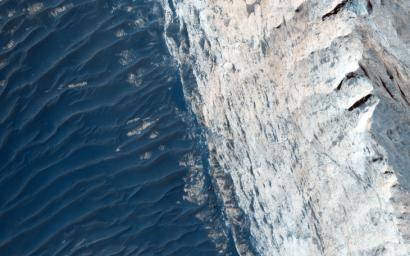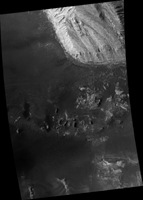
|
Layers and Fractures in Ophir Chasma
- Click the image above for a larger view
- Full-Res JPEG (2880 x 1800) (815.3 kB)
- Full-Res TIFF (2880 x 1800) (15.6 MB)
Caption:

Map Projected Browse Image
Click on the image for larger version
Ophir Chasma forms the northern portion of Valles Marineris, and this image features a small part of its wall and floor.
The wall rock shows many sedimentary layers and the floor is covered with wind-blown ridges, which are intermediate in size between sand ripples and sand dunes. Rocks protruding on the floor could be volcanic intrusions of once-molten magma that have pushed aside the surrounding sedimentary layers and "froze" in place.
Images like this can help geologists study the formation mechanisms of large tectonic systems like Valles Marineris.
(The word "tectonics" does not mean the same thing as "plate tectonics." Tectonics simply refers to large stresses and strains in a planet's crust. Plate tectonics is the main type of tectonics that Earth has; Mars does not have plate tectonics.)
Background Info:
The University of Arizona, Tucson, operates HiRISE, which was built by Ball Aerospace & Technologies Corp., Boulder, Colo. NASA's Jet Propulsion Laboratory, a division of the California Institute of Technology in Pasadena, manages the Mars Reconnaissance Orbiter Project for NASA's Science Mission Directorate, Washington.
Cataloging Keywords:
| Name | Value | Additional Values |
|---|---|---|
| Target | Mars | |
| System | ||
| Target Type | Planet | |
| Mission | Mars Reconnaissance Orbiter (MRO) | Mariner |
| Instrument Host | Mars Reconnaissance Orbiter | |
| Host Type | Orbiter | Flyby Spacecraft |
| Instrument | High Resolution Imaging Science Experiment (HiRISE) | |
| Detector | ||
| Extra Keywords | Color, Dune, Map, Volcano | |
| Acquisition Date | ||
| Release Date | 2015-11-05 | |
| Date in Caption | ||
| Image Credit | NASA/JPL-Caltech/Univ. of Arizona | |
| Source | photojournal.jpl.nasa.gov/catalog/PIA20044 | |
| Identifier | PIA20044 | |
